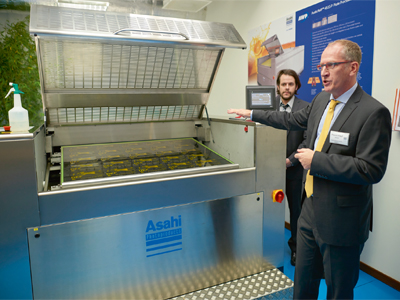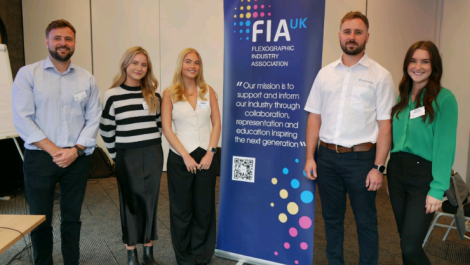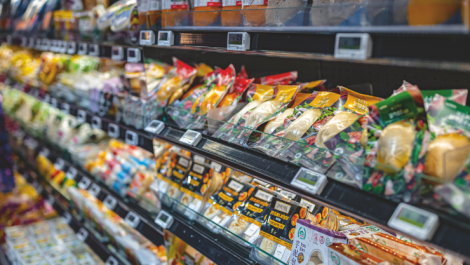Pierre Paul Moyson, European technical manager for Asahi Photoproducts, demonstrates the AWP 4835P waterwash processor.
The convenience of digital flexo plates came at the cost of the flat top dots, but plate vendors are discovering ways to build these dots into digital plates. Nessan Cleary explains.
Few people in the flexo world would argue with the convenience of using digital plates, but recently there is a clear trend toward digital plates that also incorporate flat top dots, with most suppliers now concentrating on developing these plates. Naturally, all vendors stress that not all flat top dots are equal and there are several different approaches. It is worth pointing out that analogue plates usually produce flat top dots, but that the introduction of digital imaging made it difficult to limit the effect of oxygen on the plate surface, leading to thinner, rounded dots.
Round or flat?
There are a number of distinct advantages to producing flat top dots. Perhaps the most obvious of these is that there is less risk of dot gain and hence no need for a bump curve to correct the dot gain to try to figure out what size dots should actually have been printed. Emma Schlotthauer, Kodak’s global marketing evangelist for flexo packaging, pointed out, ‘If you really want true productivity and consistency in making plates then you need to ensure that whatever you have in your digital file should end up on the plate for a true 1:1 platemaking process.’
In addition, flat top dots allow for more ink to be transferred from the plate to the substrate, producing much better solids and highlights with better gradients. But also the plates are less sensitive to pressure on the press, so they produce more consistent images throughout the run. The dots are also tougher, so more resistant to the kind of wear and tear that some substrates can cause, which generally means that they offer longer run lengths.
The main drawback is that all the plate suppliers see flat top dot plates as a premium product and charge accordingly. But Ms Schlotthauer said there is a bigger picture to be considered, because flexo plates affect the overall cost of a job, ‘It’s all about trying to get cost out of the workflow and the plate can be a major part of that,’ she said and added, ‘We realise that having a flat top dot plate is fundamentally important to making it cost effective, making sure that you can get the best properties in terms of long run length, ink transfer and plate consistency.’
But there are also advantages to round dots as Jan Scharfenberg, DuPont’s global technical manager for packaging graphics, pointed out, ‘There are still a large group of customers that are happy with a digital dot because they believe that the smallest printable dot especially in a highlight area comes from a round dot.’
In-built flatness
There are several different ways to design plates so as to achieve flat top dots, with some relying on an additional membrane, or an inert gas, while others use LED exposure or a change to the plate formulation. Mr Scharfenberg argued that the market will decide which is most popular and what people are willing to pay for them.
DuPont has just announced the Cyrel Easy plates, which use a new polymer technology that produces higher ink transfer, colour saturation and resolution. The flat top digital dots are built directly into the plates for better consistency as well as greater productivity. Naturally DuPont claims that these plates will produce better image quality with higher solid ink density without affecting the image highlight areas.
Mr Scharfenberg won’t disclose how the plate works, other than to say, ‘We change the formulation of the plate to allow a 1:1 image.’ He added, ‘We have kept the physical properties of photopolymer which comes back for durable and ink resistance. We have added the oxygen inhibition under control. There’s no extra layer on top.’ The advantage of this approach is that the plates will work with existing equipment with no further capital investment needed.
The plate performs as one would expect with no obvious limitations and will work with all standard inks and substrates. Mr Scharfenberg noted, ‘Customers would not entertain any downsides on things they are used to having. The market wants a flat top dot but without any downsides.’
DuPont has said that its developing the Easy line further to produce plates specifically for the corrugated and folding carton markets. However, Mr Scharfenberg said that the company will continue to offer both flat top and round dots, as well as smooth and engineered surfaces. He said, ‘We don’t say that flat top dot is better and that’s why we still offer both technologies but there was a strong interest in the market for flat top dots.’
First in the plate
Already in commercial use, MacDermid also has a plate technology that incorporates flat top dots into the plate. Lux In-the-Plate, or ITP, appears to use a new formulation on the plate surface, though Heather Barrett, the company’s global head of marketing, said that it is a different dot configuration to the DuPont system.
She said that MacDermid’s original approach was to add a membrane to the plate but this added an additional step, ‘After quite a bit of R&D we learned how to make the flat top dots right in the plate without the need of laminating or any gas or any specialised lighting equipment.’
The first plate that uses this technology is the ITP 60, a photopolymer plate suitable for flexible packaging and folding carton as well as sacks and paper. This offers a 1:1 mask to plate imaging so that there is no need for a bump curve, which in turn should lead to a wider colour gamut and produce a smaller dot. It can be processed with solvent or Lava thermal processors, much as any digital plate can be. However, it is only available with a smooth plate surface.
MacDermid also has a plate specifically for producing a very clean white, the MWW, which is said to reduce mottle, increase opacity, and produce brighter overprint colours. It has been designed to be used with the Lux platemaking process.
In addition, MacDermid continues to sell its Lux lamination system, which has the advantage of working with a wide range of flexo plates. It adds two extra steps, laminating a membrane to the plate after ablating it and then removing that membrane after exposure, which should take roughly five minutes, but the company claims a 30-60% improvement in dot gain together with longer press runs. As well as the original Membrane 100, there is also a version, Membrane 200, which can add flat top dots together with an applied surface pattern for improved ink transfer.
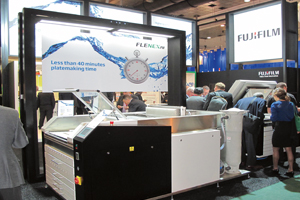
Fujifilm introduced its new Flenex FW waterwash plate to the European market at Labelexpo in Brussels.
Flat top advantage
Kodak pioneered the idea of a digital plate that could produce flat top dots with its Flexcel NX system, which was first launched back in 2008. Most vendors privately concede that Kodak single-handedly created the demand for digital flat top dot plates. The main disadvantage is that only Kodak supplies the Flexcel NX plates and the SquareSpot imagers that are key to the system, but the results are generally regarded as being extremely good.
The basic concept is relatively simple; the image is written to a film that is then laminated to the plate. The lamination process limits oxygen from reaching the plate surface, thus producing the flat top dots, while the film allows for a very high resolution image, much higher than the carbon mask used by LAMs plates, eliminating the need for a bump curve. Emma Schlotthauer said, ‘We believe there are some fundamental issues with imaging a carbon mask in terms of stability and imaging. We believe we get greater consistency which can drive greater cost savings further down the line.’
She also pointed out that Kodak offers just two plates, ‘One for post-print corrugated that is softer and one for everything else. I think that trade shops struggle with the inventory and complexity in handling lots of plates.’
The Flexcel NX system also includes the DigiCap NX screening technology, which creates a textured surface. Ms Schlotthauer explained, ‘This allows you to lay down less ink but allows more density. It lays the ink down more smoothly across the surface to avoid mottle and areas where the ink is insufficiently put down.’
Recently Kodak announced improvements to the system that are mainly to do with this surface patterning. Ms Schlotthauer said, ‘They have been optimised to fit the print process so we now have patterns optimised to work with a broad range of aniloxes out there.’ She added, ‘We are now seeing that we can further improve the visual appearance and reduce the overall cost of production and that’s really where the fundamental difference comes from. So now we can produce higher opacity whites with less ink which helps reduce the cost as white ink costs are 50% or more of a flexible packaging printers ink spend.’
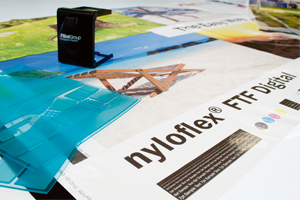
Flint recently launched the nyloflex FTF plate, which relies on LED exposure to create flat top dots in the plate.
Found in the plate
The Flint Group has been building on its nyloflex NExT technology, which is designed to create flat top dots. It relies on high intensity UV exposure through UV-A LEDs to reproduce very fine relief elements. The idea is that the plate is first exposed by scanning it with a high emission UV LED line, which sets off a chain reaction that almost instantly cross links the surface, greatly reducing the effect of oxygen. This is then followed by a second exposure, this time with UV-A tubes, which creates the relief pattern. There is no need for lamination or other consumables, and it is said to be compatible with standard pre-press software and high definition flexo.
Earlier this year, Flint launched a new nyloflex FTF digital plate using this technology. This includes flat top dots and a textured surface to ensure an even ink laydown without the need for complex surface screening. This in turn allows for increased solid ink density with a standard resolution of 2400 or 2540 dpi. It is currently available in thicknesses of 1.14 and 1.70 mm.
The new introduction follows last year’s nyloflex NEF digital plate, designed specifically for the NExT exposure technology. It is designed for high output UV LED exposure but can also be exposed with regular tube light units. Dana Contineanu, product manager for nyloflex, said that the plates can be used without the LED exposure units but that the flat top dots won’t be as pronounced. However, she added that this can still offer benefits to some customers, noting, ‘They can achieve a more even ink lay down.’
Flint also sells two exposure units, the FIII for plates up to 920 x 1200 mm, and the larger FV, for plates up to 1320 x 2032 mm, which incorporate the LEDs needed to expose these plates.
In the water
Fujifilm used the recent Labelexpo show to signal its intention to become a serious supplier of flexo plates, which makes sense given that Fujifilm’s Speciality Ink Systems, formerly known as Sericol, is a major supplier of UV inks for narrow format flexo. The company introduced its Flenex FW plates for narrow web flexo to the European market. These plates have been available in the US for the last 18 months, but Fujifilm is now keen to expand their use into other areas.
The Flenex FW plates use a rubber-based compound that limits the plate’s exposure to oxygen to reduce the dot gain. This gives a sharper dot shape and should mean that more ink is actually transferred to the substrate. Fujifilm says these plates are capable of producing a consistent 200 lpi at 4400 dpi, 1% flat top process dot structure. The plate is compatible with most flexo platesetters and waterwash processors, with Fujifilm demonstrating the ease of processing on its stand at Labelexpo with the new FWL series processor.
Asahi Photoproducts has also developed a waterwashable photopolymer plate that it calls AWP. It has taken a different approach as these plates produce round dots, but the dots are smaller so that they suffer less from the effects of dot gain. This in turn makes it easier to reproduce highlights. Traditionally, very small dots have led to inconsistent results, making them hard to work with, but Asahi claims that the smaller dots give good ink transfer without becoming clogged up with ink thanks to a special plate surface. Furthermore, Asahi claims that its plates are much tougher, with greater abrasion resistance so that they are capable of reasonably long press runs.
Asahi used Labelexpo to launch a new plate processor, the AWP 4835P specifically for the AWP plates. It has been designed to reduce the amount of water that is used, having reverse rotating and oscillating brushes to ensure optimum washout performance and a two-way filtration system to capture washed photopolymer residues. It takes plates up to 1200 x 900 mm and thickness of 1.14 and 1.70 mm. Sales director David Galton said, ‘It is engineered to deliver a sustainable quality output with fast plate access time.’

Kodak has introduced a number of new improvements to the NX brand under the umbrella term Advantage.
British firm Dantex has also concentrated its efforts on waterwashable plates with the Aquaflex range. These are available in both analogue, using a matt negative film, and digital versions, using a LAMs layer. There are several variations including the Optima, which is mainly meant for UV ink formulations, and the Aqua plate that is suitable for water-based inks. There is a separate Varnica plate for varnishing and coating applications.
Dantex’s latest plate is the Rapidoflex, an A2 plate designed for narrow web label presses. It is a water washable UV plate and is available in both digital and analogue variations. The company says that the plates can be produced in around 18 minutes.
In conclusion
It has often been noted that there is a general trend for some gravure work to migrate to flexo, and for some offset printers to compete for work that might previously have been flexo printed. The development of flexo plates that are capable of producing flat top dots, with their 1:1 image reproduction, should be seen in this context. Anything that improves the overall print quality will enable flexo printers to pitch for gravure work on the basis of achieving similar results for lower cost. Equally, these plates make for an easier overall workflow that will help flexo printers defend themselves against competition from offset.
So it is not surprising that some vendors predict that flat top dots will eventually become the mainstream plate technology. But, Mr Scharfenberg pointed out, ‘The round dot plates are established and this is a conservative industry.’ So, for now most vendors will continue to offer a choice, but we are bound to see many more flexo plates capable of directly reproducing flat top dots coming to market over the next few years.

